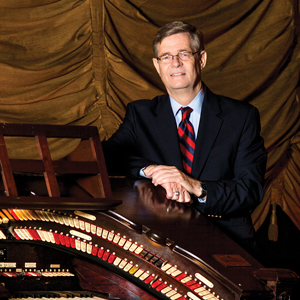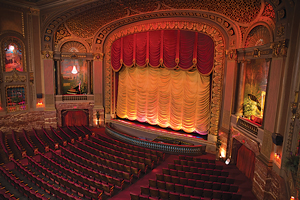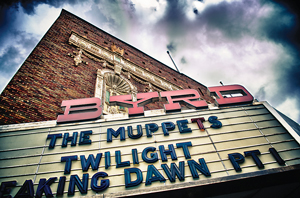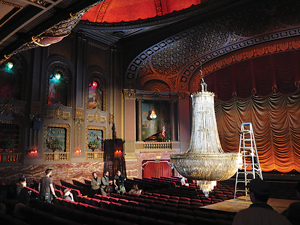Bob Gulledge sat in his seat at the Byrd Theatre eagerly waiting for the moment he could get a look at the grand theatre organ he had been hearing about. The then 13-year-old had recently moved to Richmond from Hickory, North Carolina. “I was baffled as to why the organ was there and what possible use it had,” he said.
In just a few minutes the lights in the theatre went down and Gulledge felt the building shudder ever so slightly. He watched wide-eyed as the Mighty Wurlitzer theatre pipe organ began its ascent. “You could feel the music surround you. You could see it and hear it,” he said. “When I could finally see Eddie Weaver bring the organ up over the orchestra rail, I knew I had to do that.”
 Gulledge, the Byrd’s organist for the past nineteen years, kept his vow. Intent on learning to play the organ after seeing it, he asked Weaver to give him organ lessons. Weaver suggested the teen take additional piano lessons – Gulledge had been taking piano since the age of seven – before the two could talk about the organ. Then one day “out of the blue he called the house and said, ‘Come to the Miller & Rhoads Tea Room and we will see where you are with the piano,’” Gulledge said.
Gulledge, the Byrd’s organist for the past nineteen years, kept his vow. Intent on learning to play the organ after seeing it, he asked Weaver to give him organ lessons. Weaver suggested the teen take additional piano lessons – Gulledge had been taking piano since the age of seven – before the two could talk about the organ. Then one day “out of the blue he called the house and said, ‘Come to the Miller & Rhoads Tea Room and we will see where you are with the piano,’” Gulledge said.
The teen played a few songs for Weaver on the Steinway piano and then Weaver accompanied him on the Hammond organ nearby. “He agreed to give me lessons. I would take them before the Tea Room opened for lunch,” Gulledge recalled. “I had to take lessons for over a year at Miller & Rhoads before he let me go to the Byrd for lessons. He was a wonderful teacher.”
Each one of Weaver’s students – he had a couple other than Gulledge – had the opportunity to gain experience by filling in for Weaver at the Byrd. “The better you were, the more frequently you were asked,” Gulledge said.
The organ at the Byrd was one of three theatre organs in Richmond back in the sixties and seventies. There were also organs at the Richmond Mosque (now Altria Theatre) and Loew’s Richmond (historic Carpenter Center). Gulledge was house organist for Loew’s for two years beginning in 1970. He played six nights a week. “It wasn’t a big deal, but I thought I was working at Radio City Music Hall,” he said. “I would play the overture to the movie with a 10- to 15-minute show, the same as the Byrd.”
Gulledge had no idea what a grand movie palace like the Byrd or Loew’s looked like until he went with a group from Bon Air Baptist Church to see The Greatest Story Ever Told at the Byrd in the mid-sixties. “A little town like Hickory where I had lived didn’t have grand movie houses like that,” he said.
Both a State and National Historic Landmark, the Byrd has been a movie house ever since it opened on Christmas Eve 1928. “People mistakenly think it was a vaudeville house, but it never was a live venue. That’s not to say it hasn’t occasionally had a live event there, but it’s not built for live performances at all,” said the theatre’s general manager, Todd Schall-Vess.
The movie house opened with the film Waterfront, a silent movie with sound added. The cost? A quarter for a matinee and fifty cents for an evening movie. “The theatre was well received, but the movie wasn’t a blockbuster,” Schall-Vess said. “Because the theatre opened on Christmas Eve, it was the only movie left.”
The theatre’s opening was sandwiched between the beginning of the sound age in 1927 and the Great Depression of 1929. “The Byrd was the first sound theatre to open its doors in the state of Virginia,” Schall-Vess said, adding, “That doesn’t mean we were the first place in Virginia to show sound movies. There were lots of places that added a sound system. The Byrd was the first movie theatre that opened its doors on day one as sound movie theatre.”

Often when people talk about the theatre’s organ, they focus on the console that rises out of the orchestra pit, but that is actually the smallest part of the instrument which “fills four rooms – the blower room, main or great chamber, solo chamber, and the relay room,” Schall-Vess said.
The solo and great chamber rooms above the stage house the organ pipe work, drums, bells, horns, and many other effects created by instruments. The vertical louvers act like vertical blinds to control the volume sending it from a tiny sound to a soaring crescendo. The piano in the alcove can be played
from the console of the organ as can the marimba below the harp. “The harp in the theatre isn’t playable, but the marimba creates the sound of the harp being played,” Schall-Vess said.
The first time Gulledge played for a Byrd audience was a Tuesday night. He looked out and saw a sparse crowd of roughly fifty people. Weaver met him at the theatre and brought up the organ and then introduced Gulledge who was having trouble remaining calm. “It was an absolute disaster,” he said of his performance. “My nerves took over. My hands were shaking. Even though it was only fifty people, I was feeling the pressure. I was playing a piece I knew well and I lost it.”
He met Weaver in the lobby and told his teacher he didn’t think he could go out for the second show that night. The two went over to Weaver’s house and Gulledge played the same piece again on the organ in the living room. “I played it perfectly,” he said. “Eddie told me ‘You have to go back and play the late show.’ I played the second show fine. I have never been afraid of an audience since then.”
Over the years Gulledge has shared his love of the piano first with his son and daughter and now with his three grandsons, 7-year old Tristan, 6-year-old Alexi, and Liam, two years old. “I spend a lot of time with them,” he said. “I teach piano to the two older boys.”
There’s more to the Byrd than movies and music. Anyone working in the historic movie house knows of its legends, like the ghost of former general manager Robert Coulter who worked at the theatre from 1928 to 1971. “He lived for the theatre,” Schall-Vess said. “He was one of a long line of people that loved that place.”
Neither Gulledge or Schall-Vess have seen Coulter’s ghost, but other people say they have. “The ghost has been seen seated in Coulter’s favorite spot in the balcony,” Schall-Vess said. “The first time I knew about it was in the 1980s when the theatre was reopened after a brief closing. As the story goes, some employees were using the room under the projection booth as a dressing room. They passed through the balcony and asked, ‘Who is the old dude sitting in the balcony?’ When someone went to see, the man wasn’t there. People have also seen him in the projection booth, the basement, and next to the back door at night.”

The sightings are usually in the dark during a movie. “In most cases, people mistake it for an actual person,” Schall-Vess said. “They see an old guy sitting there and then the next time you look, he’s gone.”
And then there is the ghost of a little girl that wanders around in one of the ladies’ rooms downstairs. “People that have seen her are unaware they are talking to a ghost,” Schall-Vess said. “Other people who see the person talking think she is talking to herself, because only one person at a time sees the little girl’s ghost. I don’t know who the little girl is. She is seen less frequently than Coulter. The last sighting that I know of was about three years ago.”
He isn’t completely convinced that the sightings are real. “I believe the people that have seen them are not making it up,” he said. “I think people want to believe very badly and that skews their perception of things.”
Several research groups that try to validate paranormal events have used cameras and electro-detection and recording devices to try to detect the ghosts. “They never have gotten anything that I consider substantive proof. I am still willing to be convinced, however,” Schall-Vess said.
Even though the Byrd is as grand as ever in concept, at eighty-seven it has lost some of its luster. But that’s changing. The theatre, now owned by The Byrd Theatre Foundation, is in the midst of its Journey to the Seats fundraising campaign, which has been ongoing since 2007. Monies raised will go to everything from new plumbing and electrical wiring to updated seating and the restoration of the marquee.
“Recently we had an issue with the digital projector. That is something we will have to replace sooner rather than later, so it’s moving up on the list,” Schall-Vess said. “We will be restoring the marquee soon and replacing the vertical sign that was up from 1928 to 1971.”
At first, the Foundation planned to close the theatre for up to a year during the renovation and restoration project, but that estimate has changed. “We are moving toward less time closed,” Schall-Vess said. “We think a lot of stuff can be done as we are operating the business. The current mindset is that we spend as much time open to the public as possible.”
The target date for completion of the up to $4 million project is the end of 2017. “That’s a really small figure,” Schall-Vess said of the approximate total cost. “A lot of figures for places like the Byrd can go up to $130 million, especially if the theatre has been closed.”
Currently, the theatre and Gulledge are prepping for the upcoming Fourth of July weekend sing-along. “We will be playing patriotic songs and we’ll finish with God Bless America, and when we sing the national anthem, everyone stands up,” Gulledge said. He remembers July 4, 2002, the year after the tragedy of 9/11. “The theatre was full and everyone was super-charged. When they sang the national anthem, they almost blew the roof off the place. It was very special and very emotional. It was one of the few times I have played there that I couldn’t hear the organ.”

The Byrd also features a holiday Christmas carol sing-along each year on Saturdays from Thanksgiving through Christmas. “We show [the 1946 film] It’s A Wonderful Life on Christmas Eve and Christmas Day,” Schall-Vess said. “That is big for us. It’s a celebration of the Byrd’s birthday.”
The theatre fills up on those days. “People come to sing the carols and experience the movie on the big screen. It’s my favorite night of the year in the theatre,” Gulledge said. “It’s odd to me on Christmas Eve, when the same movie is running on TV for free, that we fill the theatre. It’s a feeling of sentimentality. Singing carols and watching the movie makes it something special.”
Besides its $1.99 movie ticket price for popular second-run movies, the Byrd’s programming reflects a desire to reach patrons of all ages. There have been themed movie festivals, cult movie screenings (like Rocky Horror Picture Show and Pulp Fiction), and other original events. The Byrd is special to families with children on the autism spectrum as well. Every month on available dates, it holds a sensory-friendly screening for that special audience. This month’s screening is Sunday, July 12 at two o’clock. “We run the show with the sound down a bit and the lights up,” Schall-Vess said.
It doesn’t, however, have to be any type of special occasion for folks to get excited about being in the Byrd’s audience, especially when the organ makes its appearance before Saturday evening movies. “The audience gasps. People almost cheer when the organ comes over the rail,” Gulledge said, noting that his back is to the audience when the organ rises. “You listen to that initial response and you get that feedback. It’s the most fun you can have in a blue blazer.”
He sees the organ as the “voice of the theatre. It speaks to the audience. We have people that come to hear the organ but don’t stay for the movie. Not all the theatres that have organs get that response. We are fortunate in Richmond. We still have a good audience for that theatre and that organ.”

More Byrd Bits…
• Byrd Theatre had a Vitaphone sound system on opening day.
• It was one of the first theatres in the country to test the new Western Electric Sound System that had the soundtrack on the film to keep everything in sync.
• Ray Dolby, creator of the Dolby sound system, visited the theatre and then donated a Dolby Digital sound system.
• It is the regular venue for the Virginia Commonwealth University and University of Richmond French Film Festival, the largest French Film festival in North America.
• It has been hosting local movie previews since the 1960s.
• An 18-foot, two-and-a-half ton Czechoslovakian crystal chandelier is suspended over the auditorium. It contains over 5,000 crystals illuminated by five hundred red, blue, green and amber lights.
• The theatre’s decor was designed by the Brunét Studios of New York. Arthur Brunét, a classically trained artist, created the three murals in the lobby and the murals in the alcoves. “He did art in theatres but a large percentage of it is gone now,” Schall-Vess said. “It’s likely that what we have at the Byrd is one of the most complete and intact representations of Brunét’s theatre work anywhere.”



